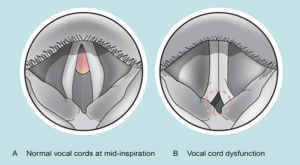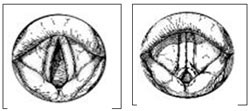Vocal Cord Dysfunction

VCD used to be called Paradoxical Vocal Fold Movement, because the vocal cords are essentially doing the opposite to what they should be doing – they close instead of opening when you breathe (see diagrams below). Symptoms and characteristics of VCD include:
- Sporadic or recurrent symptoms of shortness of breath and/or noisy breathing, much like a wheezing quality. Frequently patients complain of a tightness or ‘choking’ feeling in the throat area, although sometimes the sensation is experienced in the chest area.
- This sensation can obviously create significant fear and anxiety.
- Symptoms are frequently confused with asthma, however VCD does not resolve with puffers.
- VCD is commonly observed in young female athletes, often triggered by exercise in the first 5 minutes, however VCD occurs in many others as well.
- Patients typically experience normal voice and breathing outside of the VCD attacks.
- While a specific cause is not known, there are a number of common triggers including: laryngospasms, chronic cough, reflux disease, laryngeal dystonia, chemical exposure, upper respiratory infections, asthma, allergies, strokes, head injuries, medications, and stress.
- In some patients, the problem is constant and severe, requiring airway intervention; in others, the problem is intermittent and relatively mild.
- A careful differential diagnosis process is critical to ensure effective treatment. A team approach is usually the most effective means of identifying the problem. A team would include pulmonologists, allergists, gastroenterologists, otolaryngologists, and speech-language pathologists.
How can VCD be treated?
Speech-Language Pathologists play an important role in the assessment and treatment of Vocal Cord Dysfunction. Typically a short duration of treatment (approximately 4 to 5 sessions) is focused on increasing awareness of how the voice box works, care of the voice, and identification of triggers or stressors that may precipitate an episode of vocal cord dysfunction. A large focus of therapy is teaching effective breathing and visualization techniques to assist in managing episodes of VCD.
Image A Image B

Image A shows the vocal cords in OPEN position, which is the position vocal cords are normally in while breathing.
Image B shows the vocal cords in CLOSED position, which is the position they are normally in while speaking.
In VCD, the vocal cords move toward the closed position when breathing. This creates the sensation of shortness of breath or choking because the vocal cords are blocking the passage of air into the lungs.
HOW TO FIND A SPEECH-LANGUAGE PATHOLOGIST:
Call 877-388-3819 or email info@learcomm.ca for more information on assessment and treatment at Lear Communication. You can also contact the Ontario Association of Speech-Language Pathologists and Audiologists at www.osla.on.ca or 800-718-6752 as there may be government funded services available at your local school, hospital or Community Care Access Centre.
